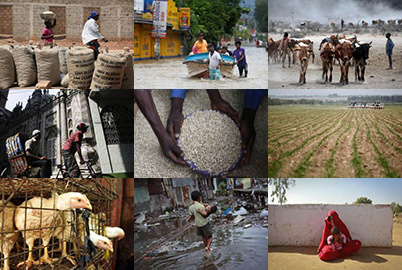With tree-lined boulevards, stately French colonial architecture and hundreds of small side alleys, Vietnam's capital Hanoi is a city steeped in culture and history. It's also a fast-growing business centre, with glass-fronted skyscrapers springing up next to century-old teak houses.
But balancing tradition and modernity isn't the only challenge for Hanoi's planners. They are strengthening the dike system to protect the city from weather-related disasters like storms and floods, which are expected to become more frequent and extreme due to global warming.
A new report backed by the United Nations warns climate change could undermine rapid economic growth in many of East Asia's cities and displace millions of their inhabitants if they don't do more to prepare for its impact.
Already an estimated 46 million people living in the region's cities are threatened every year by flooding caused by storms, according to the Climate Resilient Cities 2008 Primer.
And the report warns that a one-metre rise in sea level could lead to a 2 percent loss of gross domestic product (GDP), wiping out development gains and poverty reduction efforts in one catastrophic stroke.
Vietnam, China, Myanmar and Thailand will be most affected, it says.
Produced jointly by the World Bank, Global Facility for Disaster Reduction and Recovery and the U.N. International Strategy for Disaster Reduction (ISDR), the primer is the first practical guide linking climate change and disaster risk reduction with steps to identify the risks at the city level.
"This region already has a long history of disasters," said Jerry Velasquez, regional coordinator for ISDR, at the launch in Bangkok this month. "Climate change will bring two new elements Â? increased frequency and intensity, and maybe new hazards to areas that have not experienced disasters."
MEGA CITIES, MEGA DISASTERS
With over 30 mega cities (cities where the population exceeds five million) and many more settlements popping up in coastal areas, East Asia is experiencing rapid urbanisation.
If the trend continues Â? and experts believe Asia will see the largest increase of built-up areas by 2030 Â? the resulting urban sprawl will make the region's city-dwellers more vulnerable to disasters.
Industrialisation is also boosting the region's contribution to global warming Â? in 2000 East Asia produced almost a fifth of global emissions from burning fossil fuels.
But while governments wrangle over which country is the biggest polluter, disasters continue to affect millions of people in East Asia every year.
The number of reported disasters in the region has risen sharply since the mid-1990s, rising from 428 between 1994 and 1998 to 707 between 1999 and 2003.
As I write, Myanmar is still struggling to pick up the pieces after the devastation wreaked by Cyclone Nargis in May. And Vietnam is in the midst of its worst natural disaster this year, with scores of people killed by flooding and landslides.
Neeraj Prasad, lead environmental specialist at the World Bank, said: "It doesn't matter who's emitting the green house gases, everyone will feel the impact, more so in vulnerable communities."
The urban poor and marginalised groups are likely to be hit the hardest as they have fewer assets to help them cope.
Reluctance to curb consumption is often used as an excuse to resist change, but the report says failure to address climate change impacts will result in even worse standards of living.
PLANNING FOR THE WORST
Fortunately, it is not all doom and gloom.
Cities such as Singapore, Hanoi and Dongtan have already made efforts to climate-proof themselves, says the primer, including constructing buffer zones between the city and wetlands to minimise damage from urban development, installing warning systems and protecting forests from rivers.
"Cities need to understand that there are short-term, mid-term and longer-term actions that can and are being taken to build their resilience," said Fatima Shah of the World Bank's urban development sector unit.
These measures range from tightening building codes to promoting more efficient land use Â? in short, taking climate change into consideration across all urban planning.
First and foremost, the primer recommends determining how 'hot' or 'resilient' a city is, using a matrix that takes into account its geographical location, size, governance structure, disaster history, financial resources and city management, among other factors.
The next step is to build a city information base incorporating data and maps for use in developing disaster risk reduction policies.
But it's not just a one-off process, because adjustments will be needed as conditions change. "One never gets over becoming and remaining resilient," said Shah.
As well as continuing commitment, climate-proofing cities will also involve significant investment of financial and other resources. So how can the concept be sold to local governments, which tend to be driven by five to 10-year electoral cycles?
The report's authors suggest innovative ways of raising money to take the pressure off city hall budgets - from issuing bonds on East Asia's capital markets to tapping into carbon financing.
In the Philippines, a calamity fund was previously earmarked only for post-disaster relief, said ISDR's Velasquez. But now legislation has been passed allowing city officials to use five percent to prepare for disasters before they happen.
This - together with the example of Hanoi - suggests some city governments are taking on board the message that they can't afford to ignore climate-related disasters because they can happen in anyone's backyard at any time.
"Climate change is coming. The impacts are economic, social and they're real," said Velasquez.
Our Standards: The Thomson Reuters Trust Principles.

